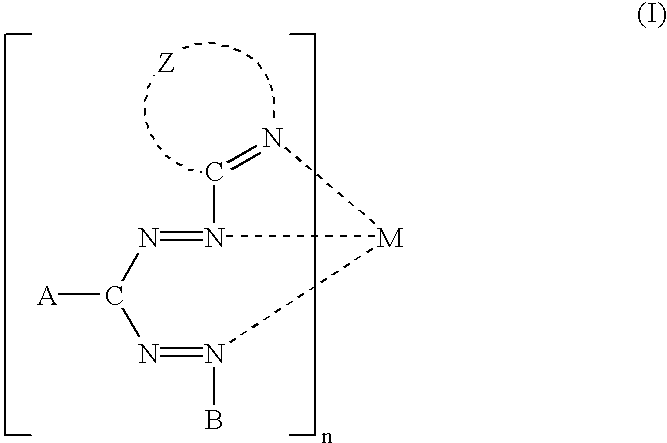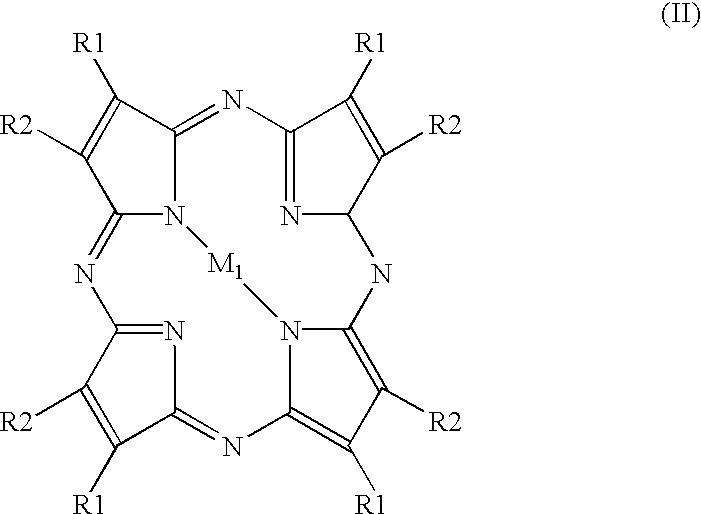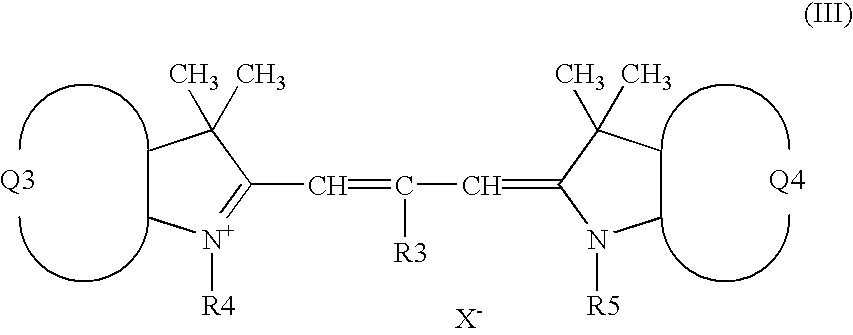Optical information recording medium
a technology of optical information and recording medium, which is applied in the field of optical information recording medium, can solve the problems of dyes having a drawback, dyes cannot have good recording/reproducing characteristics, and complex index of refraction has a large wavelength dependency
- Summary
- Abstract
- Description
- Claims
- Application Information
AI Technical Summary
Benefits of technology
Problems solved by technology
Method used
Image
Examples
example 1
[0173] The following components were dissolved in 2,2,3,3-tetrafluoropropa-nol to prepare a dye solution (i.e., a recording layer coating liquid).
[0174] Dye Compound (.alpha.)
[0175] Formazan Ni Chelate Compound (1)
[0176] having formula (I) 49 moles 7
[0177] (Z: 3,6-phenoxytriazole, A: 2-trifluoromethylphenyl, B: phenyl, M: Ni, n=2)
[0178] Trimethinecyanine Dye (2)
[0179] having fromula (III) 49 moles 8
[0180] (Q3 and Q4: a group forming a benzoindolenine ring together with a pyrrole ring, R3: --H, R4 and R5: --CH.sub.3, X.sup.-: --ClO.sub.4.sup.-)
[0181] Dye Compound (.beta.)
[0182] Pentamethinecyanine Compound (11)
[0183] having formula (VI) 2 moles 9
[0184] (Q3 and Q4: a group forming a benzoindolenine ring together with a pyrrole ring, R3: --H, R4 and R5: --CH.sub.3, X.sup.-: --ClO.sub.4.sup.-)
[0185] The recording layer coating liquid was coated by a spin coating on a polycarbonate disc having a diameter of 120 mm and a thickness of 0.6 mm, on which a guide groove having a depth of about...
example 2
[0197] The procedures for preparation and evaluation of the recording medium in Example 1 were repeated except that the dye compounds (.alpha.) and (.beta.) were replaced with the following dyes, respectively, and the solvent was replaced with a mixture solvent of tetrahydrofuran, 2-ethoxyethanol and ethylcyclohexanone.
[0198] Dye Compound (.alpha.)
[0199] Tetraazaporphyradine Compound (3)
[0200] having formula (II) 90 moles 10
[0201] (M1: Cu, R1: --O--C(CF.sub.3).sub.2--C.sub.5H.sub.6, R2: --H)
[0202] Dye Compound (.beta.)
[0203] Phthalocyanine Compound (12)
[0204] having formula (V) 10 moles 11
[0205] (M2: VO; A1, A3, A5, A7: --O--O--C(CF.sub.3).sub.2--C.sub.5H.sub.6-;
[0206] A2, A4, A6, A8: --H)
[0207] Thus, an optical information recording medium was prepared.
[0208] The evaluation results are shown in Table 2. As can be understood from Table 2, the recording medium of Example 2 has good recording sensitivity.
example 3
[0209] The procedures for preparation and evaluation of the recording medium in Example 1 were repeated except that the Pentamethinecyanine compound (11) was replaced with a dye compound (13) having formula (V), and the molar ratio of the compounds (1), (2) and (13) was changed to 46:46:8. 12
[0210] (M2: Si(OCOC.sub.4H.sub.9).sub.2; A1, A3, A5, A7: --O--CH.sub.2--CF.sub.2--CF.sub.2--CF.sub.3; A2, A4, A6, A8: --H)
[0211] The evaluation results are shown in Table 2. As can be understood from Table 2, the recording medium of Example 3 has good recording sensitivity.
PUM
| Property | Measurement | Unit |
|---|---|---|
| wavelength range | aaaaa | aaaaa |
| molar ratio | aaaaa | aaaaa |
| thermal decomposition temperatures Tα | aaaaa | aaaaa |
Abstract
Description
Claims
Application Information
 Login to View More
Login to View More - R&D
- Intellectual Property
- Life Sciences
- Materials
- Tech Scout
- Unparalleled Data Quality
- Higher Quality Content
- 60% Fewer Hallucinations
Browse by: Latest US Patents, China's latest patents, Technical Efficacy Thesaurus, Application Domain, Technology Topic, Popular Technical Reports.
© 2025 PatSnap. All rights reserved.Legal|Privacy policy|Modern Slavery Act Transparency Statement|Sitemap|About US| Contact US: help@patsnap.com



